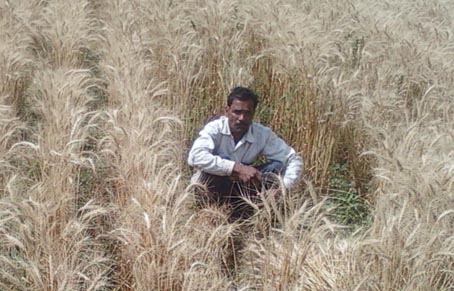
While Santkumari Kushwaha slogged and sweated out on the 2.5-acre farm of her family, her husband always wielded the exclusive power of decision-making on agriculture. All that she did until now was devoutly following her husband’s instructions. However during this wheat season, Santkumari achieved something which she never imagined she would – designing and implementing a radically-different wheat cultivation pattern. Now, after the harvest, she savours the success of her decision-making and, more importantly, appreciation from her husband.

Santkumari harvesting her trial plot
The outcome of Santkumari’s wheat trial was nothing short of spectacular. Production of her farm doubled and input cost came down by 90 per cent! Not over yet, Santkumari’s experiment achieved another remarkable feat of successfully cultivating coriander as an intercrop with wheat – a practice that is unheard of in the region!
Santkumari Kushwaha, an illiterate mother of three, was one of the first to initiate the formation of ‘Maa Durga’ small holder farmers’ collective (SHFC) formed in Itmakalan village of Satna district under Strengthening Adaptive Farming in Bangladesh, India and Nepal (SAFBIN) programme of Caritas India. While Santkumari joined an SHFC of women, her husband Lalla Prasad Kushwaha also joined the suit and became a member of a male SHFC of the village. It marked the promising beginning of a story of agriculture innovation by this enterprising smallholder farmer couple.
Caritas India’s SAFBIN programme endeavours to insulate smallholder farmers from food and nutrition insecurity by developing adaptive agriculture solutions that are efficient to meet the challenges of climate change. The programme envisages developing locally viable and affordable agriculture models. SAFBIN is being implemented in 30 villages of Satna, Sagar and Mandla districts of Madhya Pradesh. “During SHFC meetings, we tried to find out the reasons for the frequent failure of our crops. Regular discussions helped us understand the concept of climate change and how it endangers the agriculture of small farmers”, Santkumari says. SAFBIN, after holding several community-level analyses, assisted SHFCs to design field trials which blended local innovations and modern agriculture techniques that are cost-effective and nature-friendly.

Lalla Prasad with a 56-tiller wheat plant
Lalla Prasad says his wife was the first to float the idea of designing an experiment which was radically different from traditional wheat cultivation pattern. “Definitely there was a risk in doing what she had suggested. But she was sure that the risk that we would run by implementing the trial would be smaller than the certain danger that we would face in the future if we do not do it now”.
Santkumari delineated 10 x 10 meter plot of her farm for the trial and ploughed 3 times as usually done in wheat fields. However, rather than using unsorted and untreated seeds, Santkumari selected 250 gms good quality wheat seeds and treated them with an organic solution made of cow-dung, cow urine, milk and lime. Instead of broadcasting, she planted treated seeds in lines in such a way that plant to plant distance of 25 centimetres was maintained. “Distance between plants helps them grow more robustly. Earlier we did not know that even plants competed among themselves for space”, Santkumari said while detailing on System of Wheat Intensification (SWI) which she had experimented on her trial plot. Santkumari also planted coriander seeds along the spaces between the rows of wheat plants.

Lalla Prasad harvesting wheat from the trial plot
As against the normal practice of using chemical fertilisers, Santkumari administered only ‘Matka Khaad’ a botanical manure which she prepared with different measures of cow-urine, cow-dung, Neem (Azadirachta indica), Akauwa (Calotropis or milkweed) and jaggery (sugar molasses). Her crop responded well to trial combination involving seed treatment, spacing between plants and use of organic growth promoters. Wheat plants of her trial plot recorded a rare flourish unseen in the entire region as they registered tiller count as high as 56 per plant, whereas the average number of tillers in other farms was a meagre 4-6. The average length of panicle also recorded a dramatic increase to 11 cm from 7.25 and the average count of grains per panicle rose to 59.5 from 43 of plots of farmers who did not use SWI. Most significantly, Santkumari achieved all this by spending a mere Rs. 50. She used to spend nearly Rs. 500 on farms of comparable plot size for getting much lesser.
Lalla Prasad observed that the grain quality was far better in terms of weight and shine as compared to the grains of other farms. “Coriander yield from the wheat field was also good. We did not need to cultivate coriander elsewhere for meeting the household need since our wheat farm itself gave us nearly one kilogram of coriander”, Santkumari said.
The couple has now decided to bring their entire 2.5 acre land under SWI and organic farming from the next season. Expressing delight over the success of the new system of wheat cultivation Lalla Prasad said, “Ye double dhamaka widhi hai jo chote kisano ki fayada double kar deti hai” (This is a technique with double effect, which doubles the benefits for smallholder farmers.)